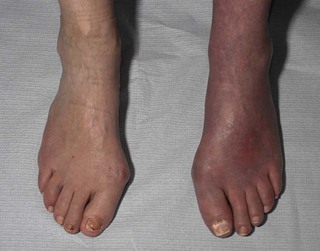14 Generalized musculoskeletal problems
Cases relevant to this chapter
Essential facts
1. Non-specific musculoskeletal pains, especially back or neck related, are common and become more prevalent with age.
2. Pain is a neuropsychological phenomenon.
3. Fibromyalgia is a syndrome characterized by widespread body pain and sleep disturbance.
4. Chronic fatigue syndromes are common and disabling.
5. Pacing, psychological and physical support, provided by a dedicated multi-disciplinary team, offer a significant opportunity for recovery.
6. Musculoskeletal manifestations of endocrine disease are dependent on age and underlying disease duration.
Chronic pain
• Complex regional pain syndrome (CRPS type I) (previously algodystrophy, Sudek’s atrophy or sympathetic dystrophy)
• Chronic fatigue syndrome (CFS)
Importance of a positive diagnosis
Many diseases present with aches and pains, general malaise and fatigue. Common ones include hypothyroidism, low vitamin D levels, diabetes mellitus, malignant disease, inflammatory joint disease and, less commonly, other autoimmune rheumatic disorders, such as systemic lupus erythematosus (SLE). It is essential when confronted by a patient with such symptoms to take a full history, paying particular attention to such factors as weight loss, change in bowel habit and the red flags associated with serious back pain (see Chapter 22).
Complex regional pain syndrome
Type II complex regional pain syndrome follows a nerve injury and was formerly referred to as causalgia. CRPS type I is characterized clinically by severe prolonged pain out of proportion to any injury, allodynia (pain on light touch to the skin), cold, clammy skin and loss of function (Fig. 14.1). Typically the skin is red and has a shiny appearance, with hypersensitivity. The exact cause of the condition is unknown. A variety of physiological abnormalities have been described including autonomic dysfunction, microcirculation abnormalities and muscle mitochondrial changes, amongst others. Radiographs taken in established cases may demonstrate osteoporosis, which is frequently patchy. Magnetic resonance imaging (MRI) shows patchy or diffuse bone marrow oedema, on T2 images. Levels of inflammatory markers are not normally raised.

FIGURE 14.1 Complex regional pain syndrome affecting the left lower limb. Note the dusky discoloration of the left foot
Rheumatic manifestations of metabolic and endocrine diseases
Many endocrine disorders have musculoskeletal manifestations. A rheumatological complaint may, therefore, be indicative of an undiagnosed endocrinopathy. An endocrine history will uncover common symptoms that suggest an endocrine cause (Box 14.1). Because endocrine and rheumatic diseases often coexist, it is important to ask about endocrine symptoms in a patient with an established rheumatological diagnosis.
In this section the common rheumatic manifestations of metabolic and endocrine disease will be discussed (Table 14.1). The more common diseases are concentrated upon, but some rarer disorders have been included if musculoskeletal symptoms are particularly prominent.
Table 14.1 Endocrine and metabolic diseases with musculoskeletal manifestations
| Endocrine Disorders | Metabolic Disorders |
|---|---|
| Diabetes mellitus | Hyperlipidaemia |
| Hyperthyroidism | Renal failure |
| Hypothyroidism | Ochronosis |
| Hyperparathyroidism | Haemochromatosis |
| Acromegaly | Lysosomal storage disorders |
| Glycogen storage metabolic myopathies |
Diabetes mellitus
Both type 1 and 2 diabetes mellitus (DM) are associated with rheumatological complaints (Table 14.2). These disorders are either unique to diabetic patients or are known to occur in the general population, but have an increased incidence in patients with DM. Musculoskeletal problems in DM are becoming increasingly common owing to the increased life expectancy of diabetic patients. The pathophysiology of these disorders in DM is poorly understood.
Table 14.2 Musculoskeletal manifestations of diabetes mellitus
| Specific to Diabetes Mellitus | Increased Prevalence in Diabetes Mellitus | Possible Association with Diabetes Mellitus |
|---|---|---|
| Limited joint mobility | Dupuytren’s contracture | Osteoarthritis |
| Diabetic amyotrophy | Palmar flexor tenosynovitis | |
| Diabetic muscle infarction | Carpal tunnel syndrome | |
| Adhesive capsulitis | ||
| DISH | ||
| Scleroedema | ||
| Neuropathic arthropathy | ||
| Bone and joint infection |
DISH, diffuse idiopathic skeletal hyperostosis.
< div class='tao-gold-member'>
Stay updated, free articles. Join our Telegram channel

Full access? Get Clinical Tree








